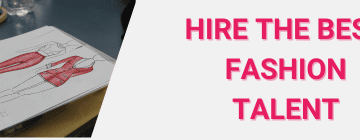Getting your foot in the door of the fashion world takes talent, connections, and the right skills to set yourself apart from other designers. As you make your way out into the fashion industry, you need to be able to communicate your style and vision with prospective buyers and manufacturers. This will allow you to take your sketches and bring to life the product line and business you’ve always dreamt of.
In order to get this done, you need to have an amazing fashion portfolio that speaks to your strengths and shares your vision with those that can help you advance in the industry, such as retail staffing agencies in New York City. By understanding the importance of a portfolio and the different types of portfolios you can work on, you’ll have the information needed to improve yours, going forward.
Why You Need a Fashion Portfolio
A fashion portfolio is your visual resume. When meeting with potential manufacturers and buyers, you need to show that your designs are worth investing in. In addition to being visually appealing, your portfolio also needs to show that you understand the industry and the obstacles that must be overcome in order to be successful. You must be able to demonstrate your industry expertise, and a dynamic portfolio is an absolute requirement.
According to CVTips, there are three main components that need to be present in your fashion portfolio: aesthetics, commercial/economic analysis, and production necessities.
- Aesthetics – Demonstrate that you understand what is currently in style. Since the fashion world is constantly changing, and styles grow and fade in popularity, your portfolio must always be up to date. This component shows you understand your potential customers.
- Economics – What will it cost to produce your clothing line? How much profit will you make from the sale of one article? Clearly defining your costs and making sure they are accurate shows your business sense and gives prospective buyers the information they need to make a decision.
- Production Needs – This comes into play when seeking a manufacturer, as you’ll need to lay out specifics in terms of material and production needs. Weighing costs and benefits is often the deciding factor, and inaccuracies in your portfolio need to be eliminated.
Without a fashion portfolio, you won’t be able to show prospective buyers or clients everything they need before continuing your relationship. A portfolio is a requirement in the fashion industry and says a lot about your commitment, attention to detail, and work ethic as a professional.
Types of Fashion Portfolios
Since the fashion industry is in a constant state of change, having a static portfolio is not going to get the job done. In addition, limiting yourself to one portfolio that includes a variety of your designs can ultimately work against you. Your portfolio should be directed at your target audience, which means that you will likely have separate portfolios that shine a light on your abilities as a designer and entrepreneur. Retail staffing agencies in New York City will expect you to have one or more of these types of portfolios, in order to be matched with a retailer that can help you achieve your goals.
- Seasonal – This includes various types of clothing relating to the particular time of the year. For example, if you are trying to market your Spring line of clothing, you want to feature pieces that customers will wear during that time of year. Be sure to update your portfolio each season, as new trends emerge and you find new inspiration.
- Business Attire – This portfolio showcases your work for professionals and should include different designs for suits, shirts, and other business attire for men and women.
- Fashion vs. Casual – These differentiate between your casual clothing designs, and pieces aimed for more sophisticated events. If your focus is on everyday wear, your portfolio should reflect that.
- Youth – Teenagers spend a good amount of disposable income on clothing and accessories, and parents make different fashion choices for young children.
The key to remember when it comes to creating your fashion portfolio is to never settle. Continue to work on your designs and marketing plan so that your portfolio remains current and is always ready for your next meeting.
Tips for Improving Your Portfolio
Now that you know the different types of portfolios to create, and some of the characteristics of an awesome portfolio, it’s time to look at what you have currently and see how you can improve. You want to be able to stand out among the waves of other aspiring designers out there, which is why perfecting your portfolio is so critical. More than just your sketches, your portfolio should also include elements that create the total package.
Source:
- “4 Fashion Design Portfolio Tips,” CVTips, n.p., n.d., Web, 3 February 2015.



